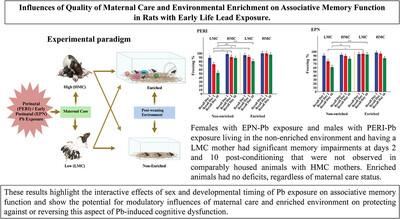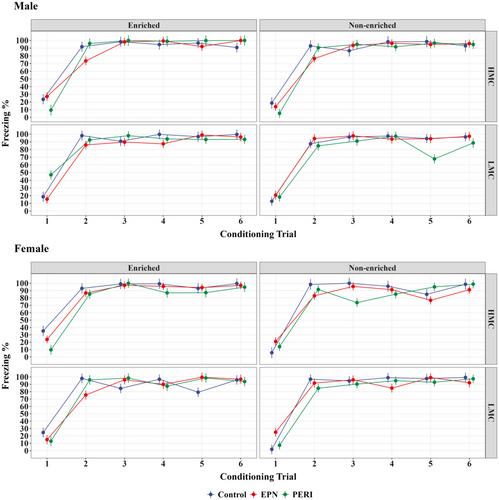Influences of quality of maternal care and environmental enrichment on associative memory function in rats with early life lead exposure
Abstract
Introduction
Children in low socioeconomic status (SES) communities are at higher risk of exposure to lead (Pb) and potentially more severe adverse outcomes from Pb exposures. While the factors encompassing SES are complex, low SES households often have less enriching home environments and parent–child interactions. This study investigated the extent to which environmental/behavioral factors (quality of maternal care and richness of the postnatal environment) may modify adverse effects from Pb exposure.
Methods
Long-Evans female rats were randomly assigned to Control (no Pb), Early Postnatal (EPN: birth through weaning), or Perinatal (PERI: 14 days pre-mating through weaning) Pb exposure groups. From postnatal days (PNDs) 2–9, maternal care behaviors were observed, and dams were classified as low or high maternal care based on amounts of licking/grooming and arched back nursing. At weaning, pups were randomly assigned to enriched or non-enriched environments. At PND 55, animals began trace fear conditioning and associative memory was tested on days 1, 2, and 10 postconditioning.
Results
Control offspring showed no significant effects of maternal care or enrichment on task performance. Females with EPN-Pb exposure and males with PERI-Pb exposure living in the non-enriched environment and having an LMC mother had significant memory impairments at days 2 and 10 that were not observed in comparably housed animals with HMC mothers. Enriched animals had no deficits, regardless of maternal care status.
Conclusion
These results show the potential for modulatory influences of maternal care and housing environment on protecting against or reversing at least one aspect of Pb-induced cognitive/behavioral dysfunction.



 求助内容:
求助内容: 应助结果提醒方式:
应助结果提醒方式:


